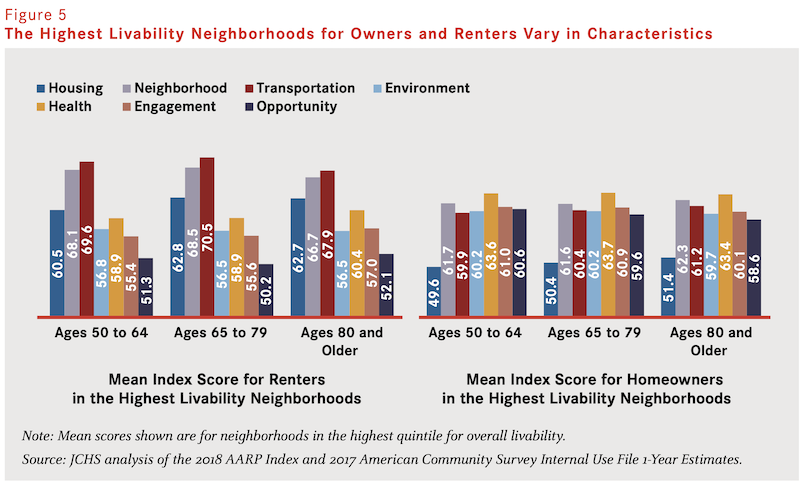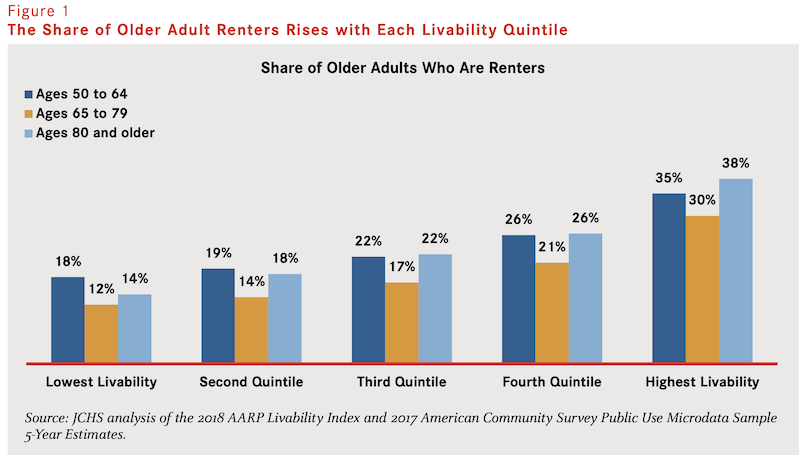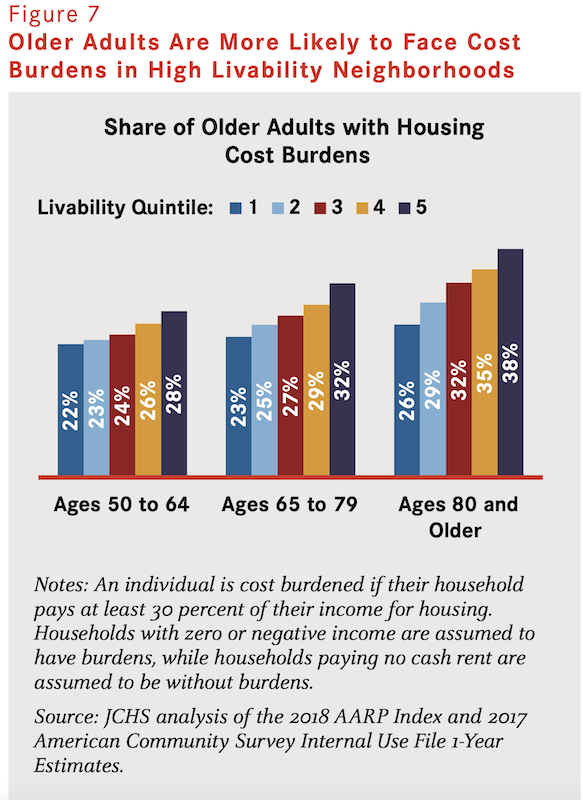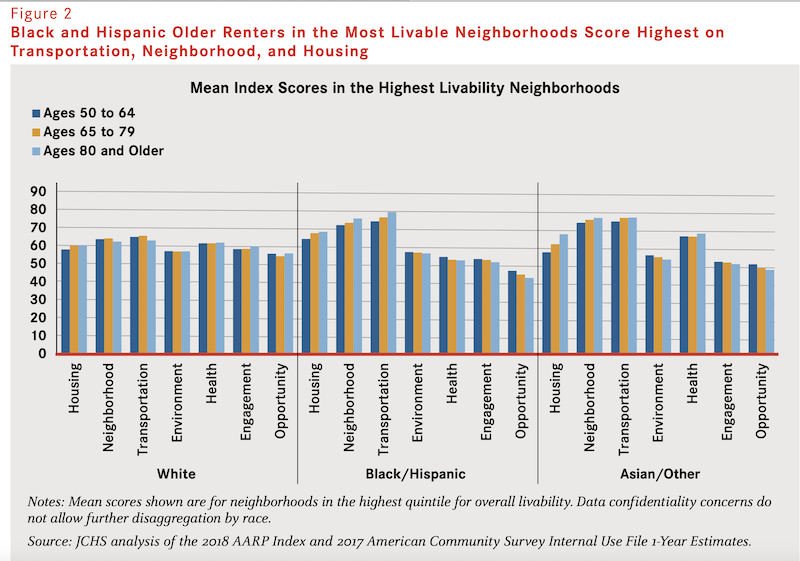Most older Americans don’t reside in “livable” communities that combine safety, security and affordability with appropriate housing and transportation options, and supportive features and services that enhance personal independence, allow residents to remain in their homes as they age, and foster residents’ engagement in civic, economic, and social life.
In a 33-page paper titled “Which Older Adults Have Access to America’s Most Livable Neighborhoods,” the Joint Center for Housing Studies at Harvard University and AARP’s Public Policy Institute draw upon information from the 2017 American Communities Survey (ACS)—whose estimates categorize 217,739 Census neighborhood block groups—as a guide to analyze AARP’s 2018 Livability Index, an online interactive source that scores neighborhoods across the U.S. to shed light on the current livability of a given location and to highlight opportunities for improvement.
The Index derives from more than 4,500 questionnaire respondents and 80 in-depth interviews, as well as input from 30 experts in various fields.

The paper also used ACS microdata to examine profiles of older adults residing in neighborhoods with different levels of livability to suggest opportunities for addressing inequality in access to livable communities, and to the specific elements certain populations lack even in the most livable places.
The paper’s goal is to evaluate whether access to livable communities is evenly distributed across the older adult population, to assess how older adults access livability features, and to understand the characteristics of higher performing communities.
DISCONNECT BETWEEN WHERE PEOPLE LIVE AND WHAT THEY NEED
Some key findings:
•Nearly 146 million Americans of all ages live in neighborhoods at the bottom two quintiles in terms of livability. And older adults are underrepresented in most livable communities; in the least livable quintile, adults age 55 or older made up near one-third of residents.
•Older adults who move tend to relocate to newer places with similar levels of overall livability as their previous neighborhoods. Only 11% move to more livable locations, and 14% actually move to neighborhoods with lower livability scores.

•There is a relationship between different types of livable neighborhoods and income, race/ethnicity characteristics, and homeownership. “At every level of livability, homeownership and income play important roles in accessing features that contribute to high scores in specific livability categories,” the paper’s authors write.
Certain themes also emerged from this research:
•Livability gap. There is a disconnect between what people have and what they need in communities to age in place.
•Housing affordability. Communities that score higher on the Index tend to have higher housing costs. High housing costs can create obstacles to accessing the benefits livable communities can provide.
•Disparities in access to specific livability features. People of color, people with disabilities, and people with lower incomes may not have access to amenities and services that support aging. As the analysis shows, even when living in high scoring communities these groups may not have access to amenities and services related to health, engagement, and opportunity.
•Mobility. People tend to move to places with similar livability levels as their previous neighborhood.
•Neighborhood preferences and location choice. Individual preferences, barriers, and available community amenities may impact people’s decisions on where to live.
POLICY SUGGESTIONS INCLUDE PROMOTING HEALTHIER ENVIRONMENTS

Livable communities tend to have diverse housing types that include more single-person households, where older adults are more likely to reside. This factor might explain why, on average, older renters live in more livable places than do older owners.
The likelihood of living in livable communities shifts somewhat with the person’s age. Among older adults, those ages 50 to 64 as well as those ages 80 and older have a slightly better chance of living in a high livability neighborhood than do those ages 65 to 79. Among those ages 80 and older, 18 percent reside in the top quintile neighborhoods but only 16 percent of those ages 65 to 79 do. In contrast, those ages 65 to 79 are more likely than other age groups to live in lower-livability neighborhoods.
The paper offers policy recommendations that focus on housing affordability and access, creating save neighborhoods that have ample food and culture available, environments that promote healthy, clean and natural places to live; and communities that supporting resident well-being and social lives, and enable economic and educational pursuits.
“By analyzing the Index in conjunction with Census block group data from the ACS, we have revealed specific areas that warrant focused attention,” the paper states. “Housing stock, tenure, and affordability have particular influences on the access older adults have to the most livable communities.” While this analysis could not reveal if the most vulnerable older people residing in livable communities have equal access to every feature, service, and amenity, “one expects they do not.”

Related Stories
Market Data | Feb 20, 2019
Strong start to 2019 for architecture billings
“The government shutdown affected architecture firms, but doesn’t appear to have created a slowdown in the profession,” said AIA Chief Economist Kermit Baker, Hon. AIA, PhD, in the latest ABI report.
Market Data | Feb 19, 2019
ABC Construction Backlog Indicator steady in Q4 2018
CBI reached a record high of 9.9 months in the second quarter of 2018 and averaged about 9.1 months throughout all four quarters of last year.
Market Data | Feb 14, 2019
U.S. Green Building Council announces top 10 countries and regions for LEED green building
The list ranks countries and regions in terms of cumulative LEED-certified gross square meters as of December 31, 2018.
Market Data | Feb 13, 2019
Increasingly tech-enabled construction industry powers forward despite volatility
Construction industry momentum to carry through first half of 2019.
Market Data | Feb 4, 2019
U.S. Green Building Council announces annual Top 10 States for LEED Green Building in 2018
Illinois takes the top spot as USGBC defines the next generation of green building with LEED v4.1.
Market Data | Feb 4, 2019
Nonresidential construction spending dips in November
Total nonresidential spending stood at $751.5 billion on a seasonally adjusted annualized rate.
Market Data | Feb 1, 2019
The year-end U.S. hotel construction pipeline continues steady growth trend
Project counts in the early planning stage continue to rise reaching an all-time high of 1,723 projects/199,326 rooms.
Market Data | Feb 1, 2019
Construction spending is projected to increase by more than 11% through 2022
FMI’s annual outlook also expects the industry’s frantic M&A activity to be leavened by caution going forward.
Market Data | Jan 23, 2019
Architecture billings slow, but close 2018 with growing demand
AIA’s Architecture Billings Index (ABI) score for December was 50.4 compared to 54.7 in November.
Market Data | Jan 16, 2019
AIA 2019 Consensus Forecast: Nonresidential construction spending to rise 4.4%
The education, public safety, and office sectors will lead the growth areas this year, but AIA's Kermit Baker offers a cautious outlook for 2020.

















